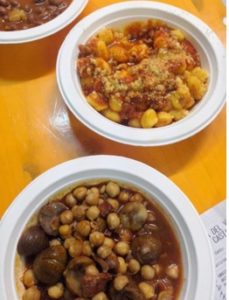Ci scusiamo. Al momento non è disponibile alcuna traduzione italiana per questa pagina.
— by Anne Robichaud – An Umbrian tour guide in Italy most of the year, Anne also teaches Umbrian rural cuisine in private homes in the U.S. in February and March (see www.annesitaly.com/united-states-events/u-s-cooking-classes)… and lectures.
San Martino, Umbria – Rural people baptized it l’albero del pane (“the bread tree”) for this tree grew on the mountains where wheat would not grow (and if elevation was also too high for olive trees, walnuts gave oil). The chestnut has starred in the culinary history of many civilizations and nowadays, highlights many a central Italy food festival.
 To discover the apex of chestnut culinary creativity, don’t miss the mid-November Festa del Vino e delle Castagne (Wine and Chestnuts Festival) of San Martino in Colle, a minuscule castle-village near Perugia.
To discover the apex of chestnut culinary creativity, don’t miss the mid-November Festa del Vino e delle Castagne (Wine and Chestnuts Festival) of San Martino in Colle, a minuscule castle-village near Perugia.
As you enter the village through the medieval arch, you’ll see red-cheeked Signor Agostino roasting chestnuts over an open fire. At a stand nearby, a volunteer sells il vino novello (new wine, i.e. of this year’s harvest). Chestnuts and wine are inextricably linked in central Italy’s rural culture. A much-loved saying, “San Martino, San Martino, castagne e vino” (“San Martino, San Martino, chestnuts and wine”) comes to life here in Umbria on November 11th, the feast of St. Martin, when rural families gather to inaugurate their new wine with roasted chestnuts.
And some festival visitors head here just for roasted chestnuts and vino novello. Others opt for a pre-chestnut hot sandwich: sliced roasted sausages (Signor Agostino on the job) slipped into torta, the Umbrian hearth bread, perhaps topped with mixed greens sautéed in garlic and olive oil. Or torta con barbozza (razor-thin, transparent slices of pork cheek).
If you’re there for full castagna indulgence, head into the food tent, just on the other side of the fire. Young volunteers serve up the indescribable goodness: the night we were there, chickpea/chestnut soup, home-made gnocchi with Umbrian meat sauce, bean soup with pigskin, mixed greens of spinach, Swiss chard and chicory sautéed in garlic and olive oil. Main course headlining that night? Roast pork smothered in a buonissimo chestnut sauce. Desserts? With chestnuts, of course. Two tasty tarts.
In the tent kitchen, older volunteers cooked the feast. Peppa was plucking pheasants for the pheasant-stuffed ravioli (for the following night), flanked by Ezio rolling out the gnocchi. Bald retired baker Giovanni (“for over fifty-years, I baked from midnight to 8 a.m.”) handled the torta bread-baking and Signora Rita split open torta slices for the filling with sausages, prosciutto or barbozza. Retired butcher Romano sliced barbozza and prosciutto with arthritic hands (“I’ve been doing this butchering work since I was seven. Pain-killers help me…”).
After our feast, we looked at the upcoming weekend menu of tasty dishes, posted near the tent door: the chestnut-filled gnocchi and the chestnut ravioli were enough to set our sights on a comeback.
